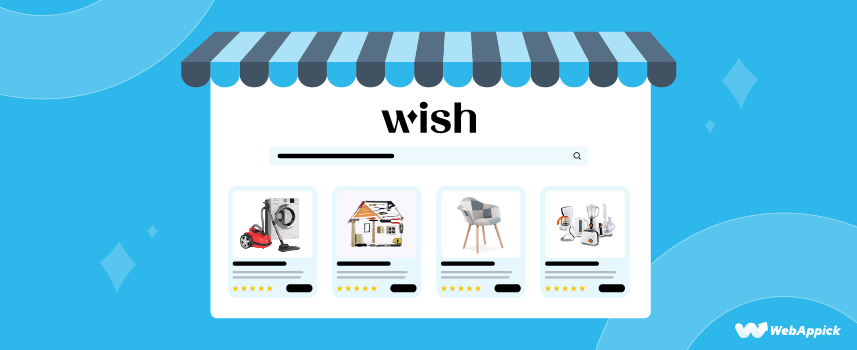
How to Create a Wish.com Product Feed (Step-by-step)
Creating a Wish.com product feed for your WooCommerce store means generating a structured CSV file that includes key Wish attributes—such as id, title, description, price, inventory, condition, image_link, brand, SKU, and GTIN—so the Wish Merchant platform can correctly list, categorize, and advertise your products.
Instead of building this feed manually, a feed automation tool like CTX Feed – WooCommerce Product Feed Plugin uses Wish’s built-in ontology and template requirements to automatically map your WooCommerce product data, format it properly, and produce a ready-to-upload product feed that you can submit directly to your Wish Merchant account.
Have enough time? If yes, let’s dive in.

Why Should You Sell Your Products on Wish.com: The Benefits
Before you proceed on learning the Wish product feed generation process, let’s see some of the advantages or key reasons why you should sell your products on Wish.com.
- Wish.com has a global user base. Using this marketplace, you can sell and ship your products to 62 countries. According to Wish.com, 49% of its users are from North America and 36% from Europe, and 15% from the rest of the regions of the world.
- This platform provides automated currency exchange rates.
- As it supports 30+ international customer language translations, you can use the automated translation of product titles into supported languages. (However, you should also be able to do it with the CTX Feed plugin combined with the multilingual plugins).
- Wish.com is optimized for mobile devices. It will allow you to reach customers on the go.
- Your products will get better visibility to the people of the world by using the promotion and advertisement system integrated with Wish. Wish will help you show your products to global customers strategically.
- By selling on Wish.com, you can tap into a new customer base that may not have discovered your WooCommerce products otherwise.
- Wish.com has a simple and user-friendly interface that makes it easy for you to set up and manage your online store.
Required Product Feed Specifications for Wish.com Product Feed
It doesn’t matter whether you’re adding your products to Wish manually, via CSV, via API, or via Merchant dashboard, it is mandatory for you to include certain attributes to your Wish.com product feed.
If you’re going to add or edit products via CSV, you can follow the table below to know about the required attributes for your feed:
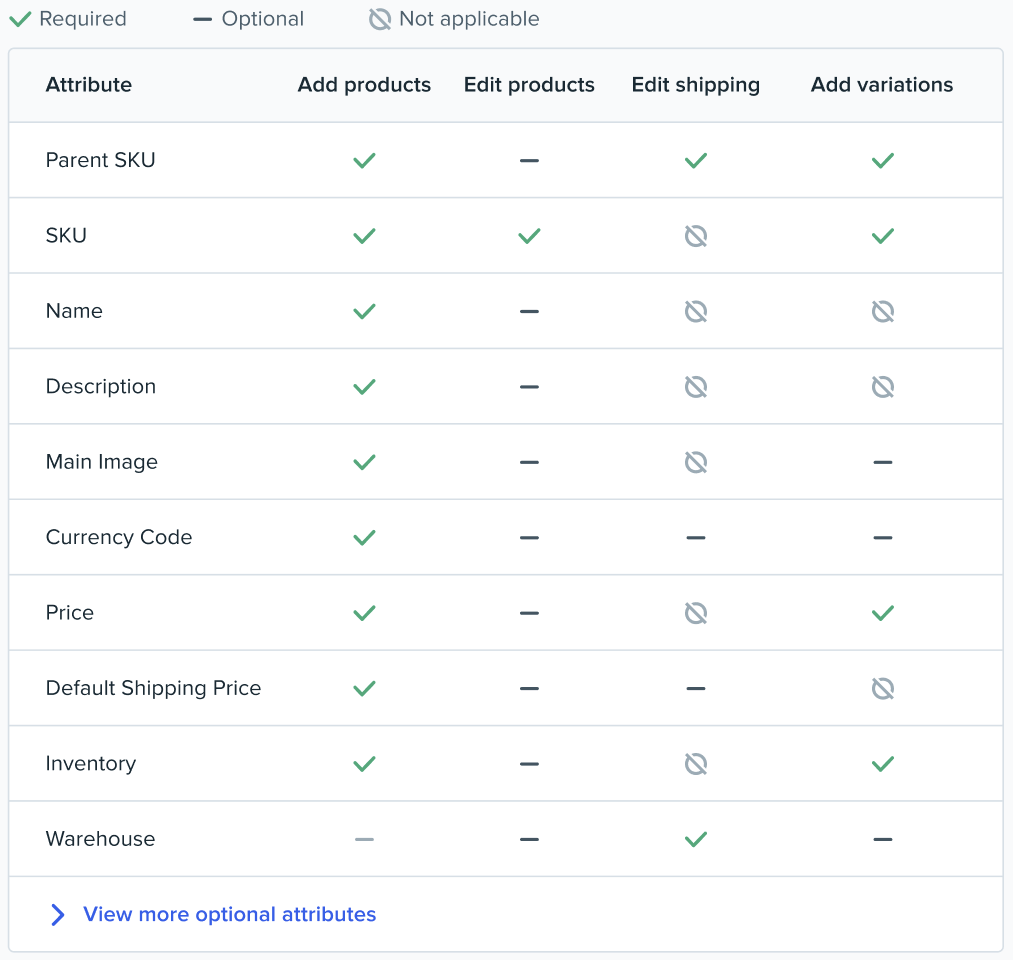
Let’s give you a description of the required attributes so that you have a complete idea of what a Wish product feed is all about. Knowing about these attributes will help you add or edit products manually via CSV, merchant dashboard, and API.
Parent SKU
Type: String
When you want to define the variation of a product, it is important for you to know the product to which you’re going to add the variations. It’s the ‘Parent SKU’ to which you can attach the variant. You must include the Parent SKU either in your upload or on Wish to add the variant.
Examples:
- Acceptable format: UIC768QQ
- Acceptable format: 987558987630987
- Unacceptable format: 5
- Unacceptable format: b
SKU
Type: String
A Unique SKU is used internally to identify an item in the store. You must keep this SKU number for any updates in the SKU number to the item in the future. Wish uses this SKU number not to just track or identify the item, but also for updating and reporting accordingly.
Examples:
- Acceptable format: UIC768QQ
- Acceptable format: 987558987630987
- Unacceptable format: 5
- Unacceptable format: b
Name
Type: String
You should use the following template to build your product names: Main brand + Sub-brand, family or product name + Up to 3 key attributes + Generic product type.
Note that, the names of your product must be clear as well as concise. Your product name should describe the products being sold exactly as it is. If you follow the template above, your customers will be able to identify your product easily.
Names must be clear and concise and should also be descriptive of the product being sold. This template will help customers identify your product.
Examples:
- Acceptable format: Canon EOS 300D DSLR Camera (Body Only) CHINA MODEL
- Acceptable format: Acer E5 15.6″ Laptop
- Unacceptable format: Best Price!!! ***LOWEST PRICE*** Macbook Pro!!!
Description
Type: String
Here you have to use a detailed description of a product. While the character limit is 4000, the initial search page will display only the first 250 characters.
While writing the product description, make sure that you avoid using any HTML code, store policies, other store-specific languages, or even multiple lines.
If you use new-line characters like ‘enter’ or ‘return’, it will cause issues with your file. For apparel items, it’s okay to include the size, fit, and measurements to describe your product better.
Examples:
- Acceptable format: This t-shirt is 100% pure cotton, unisex, and comes in S, M, XL, and XXL sizes.
- Unacceptable format: This <b>t-shirt</b> is 100% pure cotton, unisex, and <i>fits true to size</i>.
Main Image (previously Main Image URL)
Type: URL
This is the URL of your product photo which redirects the users directly to the image (but not to the landing page where the image is). Wish.com accepts either JPEG or GIF format for images.
When you submit photos for Wish.com, make sure that you do not add any company logos, names, promotional text, or any kind of irrelevant text inside the image.
Your product image should at least be 100 x 100 pixels in size. Avoid using any “image not found” images. Wish.com does not accept image URLs that begin with https://.
Examples:
- Acceptable format: http://www.yourdomain.com/images/67899/3
- Acceptable format: http://www.yourdomain.com/images/shirt.jpg
- Unacceptable format: https://www.your domain.com/images/56783/3
- Unacceptable format: http://www.yourdomain.com/images/shirts.html
Currency Code (previously Local Currency Code)
Type: String
This is your local currency code that you use for all of your products. This must match your localized currency.
Examples:
- Acceptable: USD
- Acceptable: BDT
- Unacceptable: Chinese
Price
Type: Price
It indicates the local currency price of your product. The buyers will pay this amount for the product after the prices have been converted to your currency.
Examples:
- Acceptable: 100
- Acceptable: 20.99
- Unacceptable: 69.99 + S/H
Default Shipping Price (previously Shipping)
Type: Object
The default shipping price of your product applies automatically as the shipping price for any new or unset countries in this warehouse.
Examples:
- Acceptable: 100
- Acceptable: 20.99
- Unacceptable: 69.99 + S/H
Inventory (previously Quantity)
Type: Integer
This is the amount of an SKU that is available in stock. For Wish specified inventory, you should use inventory buffering. The maximum inventory size is 500,000. Larger inventories will be lowered automatically.
Examples:
- Acceptable: 1300
- Acceptable: 0
- Acceptable: 9
- Unacceptable: In stock
- Unacceptable: Out of Stock
Warehouse
Type: String
Provide the unique warehouse name you use internally to identify a warehouse. Shipping price and inventory are applied to the specified warehouse only. If you do not define one, they are applied to the default warehouse attached to your account.
Examples:
- Acceptable: US_47907
- Acceptable: SZ_CN
- Unacceptable: 3
- Unacceptable: b
Optional Attributes for Wish.com Product Feed
Check a list and description of optional (not mandatory but good to have) attributes for the Wish.com product feed below:
Extra Images (previously Extra Image(s))
Type: String
Here you need to insert a list of URLs of images of the product. If you have more URLs than one, you have to separate the URLs by using the symbol ‘|’.
Make sure to link directly to the image, instead of the product page where the image is located. The order of the URLs will be the order of the images displayed on the product page.
If you want to update the existing images or add new images, you need to provide all extra image URLs, including the ones that remain the same.
If you do not provide any extra image URLs, no update will be done.
Provide REMOVE_ALL to unset all existing extra images.
When it comes to image formats, Images can be in JPEG, PNG or GIF format.
Extra images should be at least 100 x 100 pixels in size.
Examples:
- Acceptable format: http://www.yourdomain.com/images/952064/3 | https://www.yourdomain.com/images/shirts.jpg
- Acceptable format: http://www.yourdomain.com/images/shirts.jpg
- Acceptable format: REMOVE_ALL
- Unacceptable format: https://www.your domain.com/images/0349857/3
- Unacceptable format: http://www.yourdomain.com/images/shirts.html
Variation Image
Type: String
This is the URL of a photo of your product.
You should link directly to the image, not the page where it is located.
Wish accepts JPEG, PNG, or GIF format.
Avoid using company logos or names or promotional or other identifying text.
When it comes to image size, Images should be at least 100 x 100 pixels in size.
Avoid using any “image not found” images.
Last but not least, Wish does not accept image URLs that begin with https://.
Examples:
- Acceptable format: http://www.yourdomain.com/images/876543/3
- Acceptable format: http://www.yourdomain.com/images/shirts.jpg
- Acceptable format: REMOVE_ALL
- Unacceptable format: https://www.your domain.com/images/987655/3
- Unacceptable format: http://www.yourdomain.com/images/shirts.html
Clean Image
Type: String
This is the URL of the Clean Image of your product.
This must be the same Wish URL as the Main Image URL or one of the existing Extra Image URLs or the URL of a newly added image.
Products with a Clean Image selected may receive increased impressions and sales.
Examples:
- Acceptable format: http://www.yourdomain.com/images/987667/3
- Acceptable fromat: http://www.yourdomain.com/images/shirts.jpg
- Unacceptable format: https://www.your domain.com/images/56789/3
- Unacceptable format: http://www.yourdomain.com/images/shirts.html
Video URL
Type: String
This is the URL of the demo video that was uploaded for this product.
Examples:
- Acceptable format: http://www.yourdomain.com/videos/demo.mp4
- Unacceptable format: https://www.youtube.com/watch?v=19876789
- Unacceptable format: http://www.yourwebsite.com/video/shirts.html
Brand ID
Type: String
Include the product brand ID of the product being sold.
The product you’re selling must be authentic and directly manufactured by the brand owner.
For example, Apple is the Brand of iPhone or iPad but Apple is not the Brand of an iPhone case not manufactured by Apple.
See Brand Directory https://merchant.wish.com/branded-products/brand-directory to view a list of brands to select from or request a new brand to be added.
Examples:
- Acceptable: 545d5e6a656789r78u98f835
GTIN (previously UPC)
Type: String
It’s 12 to 14 digits GTIN (UPC, EAN, ISBN) that contains no letters or other characters. It’s a barcode symbology used for tracking trade items in stores and scanning them at the point of sale (POS).
Examples:
- Acceptable: 12345678912345
- Unacceptable: asdf123456ds
Reference Price (previously MSRP)
Type: String
To mention the reference price or comparison, a field is usually included in the listings. It is not required for the merchants to input a value for reference value.
However, in case merchants want to provide a reference price value, it is important that each reference price complies with the product reference price policy.
Examples:
- Acceptable: 12345678912345
- Unacceptable: asdf123456ds
Color
Type: String
This is the color of the product. It is important to have an own row for each color variation along with the inventory level and unique SKU.
In case you want to display two colors simultaneously, you can separate the colors using the “&” symbol (e.g., green & white).
By the way, do not confuse products with two colored variations with showing two colors.
Please note that showing two colors here should not be confused with products having two different colored variations. The name of the color must be in the list of currently accepted colors.
Examples:
- Acceptable: red
- Acceptable: black & blue
- Unacceptable: red, blue
- Unacceptable: black & blue & green
Size
Type: String
Mentioning the size of the product is important for buyers, especially of apparel, jewelry, and footwear.
For each size variation, you have to create a row in the feed with their unique SKUs and inventory levels. Note that the size format must be a number or any of the accepted sizes such as XXL.
Examples:
- Acceptable: M
- Acceptable: XL
- Acceptable: 19
- Acceptable: 42
- Unacceptable: small
- Unacceptable: XXL, M
Tags
Type: String
Tags are non-hierarchical keywords or terms that you assign to your product in the feed. When you add this type of metadata, the shoppers can find a product easily. On top of that, tags help you describe your products and get them categorized precisely on Wish.com.
When it comes to tags, they are usually separated by a comma. However, it’s important to remember that you should not use commas in individual tags. If you use more tags and with more accuracy, the visibility of your products increases on the platform. You can add up to 10 tags for a product. If you add more, Wish will ignore those extra tags.
Examples:
- Acceptable: Shirt, Black, Formal, Apparel
- Acceptable: Men’s Fashion, Jewelry & Bags
- Acceptable: Chinese, Women’s Fashion, Handcrafted
- Unacceptable: Stock Clearance Sale
- Unacceptable: Cheap Discounted Get Now
- Unacceptable (Too many tags): Shirts, Cotton, Chinese, Women’s Fashion, Handcrafted, Fashion Wear, Top Quality
Enabled
Type: String
Enable this SKU on Wish. Shoppers will be able to view and purchase the product.
Examples:
- Acceptable: 1
- Unacceptable: True
- Unacceptable: Enable
Disabled
Type: String
Disable this SKU on Wish. Shoppers will not be able to view or purchase the product.
Examples:
- Acceptable: 1
- Unacceptable: True
- Unacceptable: Disable
Unit
Type: String
This indicates the unit of measurement for the total content of a product. It displays the price per unit of a product (per the below formula) and is the unit of measurement that will be used for both the Reference Value and Quantity Value attributes.
(Price * Reference Value) / Quantity Value = Unit Price (displayed per Reference Value in given Unit)
Examples:
- Weight: ounce, pound, gram, milligram, kilogram
- Volume US imperial: fluid_ounce, pint, quart, gallon
- Volume metric: milliliter, centiliter, liter, cubicmeter
- Length: inch, foot, yard, centimeter, meter
- Area: square_foot, square_meter
- Per unit: count, load, wash, roll, pod
Reference value
Type: Number <float>
The reference value (in the given unit) that is used to calculate the price per unit of a product and to illustrate the unit count for the consumer to see, using the below formula.
(Price * Reference Value) / Quantity Value = Unit Price (displayed per Reference Value in given Unit)
As an example, you are listing a 200-milliliter bottle of perfume for $33.12 and would like to display the price per 100 milliliters:
- Measured Type = Volume metric
- Unit = milliliter
- Quantity value = 200
- Reference value = 100
- Unit Price = ($33.12 * 100) / 200 = $16.56 per 100 milliliter
➤ Read this guide for more.
Examples:
- Acceptable: 100
- Acceptable: 38
- Unacceptable: EFGHI
Quantity value
Type: Number <float>
The total quantity of the product variant (in the given unit) that is used to calculate the price per unit of a product, using the below formula. Note that if a product has multiple product variants, you will need to set quantity values for each product variant.
(Price * Reference Value) / Quantity Value = Unit Price (displayed per Reference Value in given Unit)
As an example, you are listing a 200mL bottle of perfume for $33.12 and would like to display the price per 100mL:
- Measured Type = Volume metric
- Unit = mL
- Quantity value = 200
- Reference value = 100
- Unit Price = ($33.12 * 100) / 200 = $16.56 per 100mL
Examples:
- Acceptable: 1
- Acceptable: 15
- Unacceptable: EFGHI
Package Height
Type: Decimal
The height of the package in which your product will ship to the customer (Units in cm).
Examples:
- Acceptable: 67.80
Package Width
Type: Decimal
The width of the package in which your product will ship to the customer (Units in cm).
Examples:
- Acceptable: 45.50
Package Length
Type: Decimal
The length of the package in which your product will ship to the customer (Units in cm).
Examples:
- Acceptable: 45
Package Weight
Type: Decimal
The weight of the package in which your product will ship to the customer (Units in g).
Examples:
- Acceptable: 50.80
- Acceptable: 44
Pieces Included
Type: Integer
The number of pieces that are associated with this item.
Examples:
- Acceptable: 5
- Acceptable: 3
- Unacceptable: -4
Contains Liquid
Type: Boolean
Whether the product contains liquid.
Examples:
- Acceptable: Yes
- Acceptable: No
- Unacceptable: 0
Contains Metal
Type: Boolean
Whether the product contains metal.
Examples:
- Acceptable: Yes
- Acceptable: No
- Unacceptable: 0
Contains Powder
Type: Boolean
Whether the product contains powder.
Examples:
- Acceptable: Yes
- Acceptable: No
- Unacceptable: 0
Contains Battery
Type: Boolean
Whether the product contains a battery/batteries.
Examples:
- Acceptable: Yes
- Acceptable: No
- Unacceptable: 0
Country of Origin
Type: String
Country where the product is manufactured. Country code should follow ISO 3166 Alpha-2 code.
Examples:
- Acceptable: CN
- Acceptable: US
- Unacceptable: China
Declared Name
Type: String
Declared name for logistics.
Examples:
- Acceptable: Power Tools Kit Set
- Acceptable: Rings
- Unacceptable: !Rings
- Unacceptable: T
- Unacceptable: Good 衬衫
- Unacceptable: Name that is longer than 200 characters
Customs HS Code
Type: String
Harmonization System Code used for customs declaration.
Examples:
- Acceptable: 45671010.00
- Acceptable: 2345.10
- Unacceptable: 2
- Unacceptable: a
Customs Declared Value
Type: String
The price (in USD) of your product that will be declared to the customs.
Examples:
- Acceptable: $45
- Acceptable: 13.50
- Unacceptable: $49.99 + S/H
Max Quantity
Type: String
The maximum quantity of products per order. This lets users break down large orders for easy management and tracking. This should only be used in rare cases.
Examples:
- Acceptable: 90
- Acceptable: 11
- Acceptable: 1
- Unacceptable: 0
US TTD
Type: Integer
The specified time-to-door for the given country or region. Time-to-door is measured as the time from when the order was placed to when the order was confirmed delivered.
If the delivery for this country is disabled, this column must also be set to ‘disabled’. To update TDD for a different country/region use their 2-letter country code instead of US.
Examples:
- Acceptable: 3
- Unacceptable: one
- Unacceptable (over 15 days): 25
- Unacceptable (non-positive): -3
- Unacceptable (non-integer): 20.5
US
Type: Price
The localized country shipping price for customers that purchase in the United States. To update the localized shipping price for a different country use their 2-letter country code instead of the US.
Examples:
- Acceptable: 1.99
- Unacceptable: 1.99+
- Acceptable: disabled
- Acceptable: enabled
US_HI
Type: Price
The regional shipping price for customers that purchase in Hawaii, United States. You can specify “disabled” or “enabled” to determine whether users in this region can buy the product.
You can also specify “use country shipping price” to unset the regional shipping. To update the shipping price for a different region use their country code + ‘_’ + region code defined here instead of US_HI.
Examples:
- Acceptable: 1.99
- Acceptable: disabled
- Acceptable: enabled
- Acceptable: use country shipping price
- Unacceptable: 1.99+
Condition
Type: String
Provide the condition of the product. You can choose “New,” “Used,” or “Refurbished.”
NOTE: Make sure to provide this information so that the product’s European Union-bound orders may smoothly pass through customs.
Examples:
- Acceptable: New
- Acceptable: Used
- Acceptable: Refurbished
- Unacceptable: Old
California Proposition 65 Warning Type
Type: String
Provide the warning type applicable to your product, if any, for compliance with California Proposition 65.
You can choose “Chemical,” “Food,” “Furniture,” “On_Product_Cancer,” “On_Product_Combined_Cancer_Reproductive,” “On_Product_Reproductive,” “Raw_Wood,” or “Diesel_Engines.”
Examples:
- Acceptable: Chemical
- Acceptable: Food
- Acceptable: On_Product_Cancer
- Unacceptable: Other
California Proposition 65 Chemical Names
Type: String
Provide the specific chemical name(s) applicable to your product, if any, for compliance with California Proposition 65. If you selected the Food, Furniture, or Chemical warning type (see previous attribute), you must provide at least one specific chemical name.
When using CSV, provide a list of chemical names, separated by ‘|’. You can provide up to a maximum of 5 chemical names.
Examples:
- Acceptable: Benzyl Chloride
- Acceptable: Lead
- Acceptable: Nalidixic Acid
- Unacceptable: Chemical
How to Create a Wish Product Feed in 5 Simple Steps
Now that you know the importance along with the required and optional product feed attributes of a Wish product feed, it’s time to start generating a Wish product feed. We’re going to show you one of the simplest ways to create a Wish product feed below.
What You’ll Need
- An eCommerce store on WordPress powered by WooCommerce
- CTX Feed (Free/Pro) plugin.
- Wish Merchant account
That’s all.

Step 1: Install CTX Feed (Free/Pro) plugin
If you’ve got an eCommerce store powered by WooCommerce, the second thing you need to start making a Wish product feed for your WooCommerce store is CTX Feed Pro.
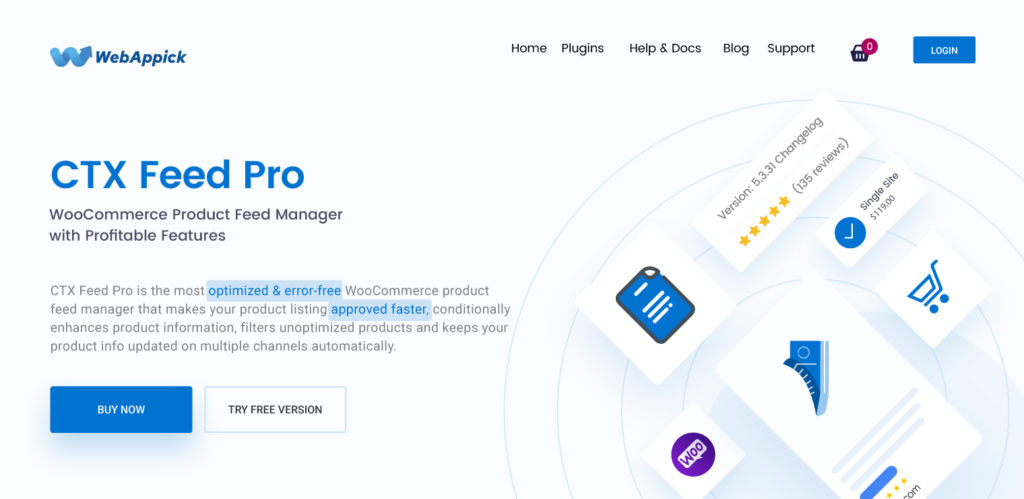
This WooCommerce product feed generator will let you create a product feed for Wish along with 130+ more platforms. There is both free and pro version of the CTX Feed plugin.
One of the key reasons why you should use this plugin is the readymade templates made for Wish and other platforms.
These readymade templates will allow you to select the template of the marketplace for which you’re making a product feed and this plugin will automatically come up with a template with all the required attributes.
This plugin will allow you to customize the product feed as per your preference.
To start with, you can install the free version from your WordPress admin panel by going to Plugins > Add New.
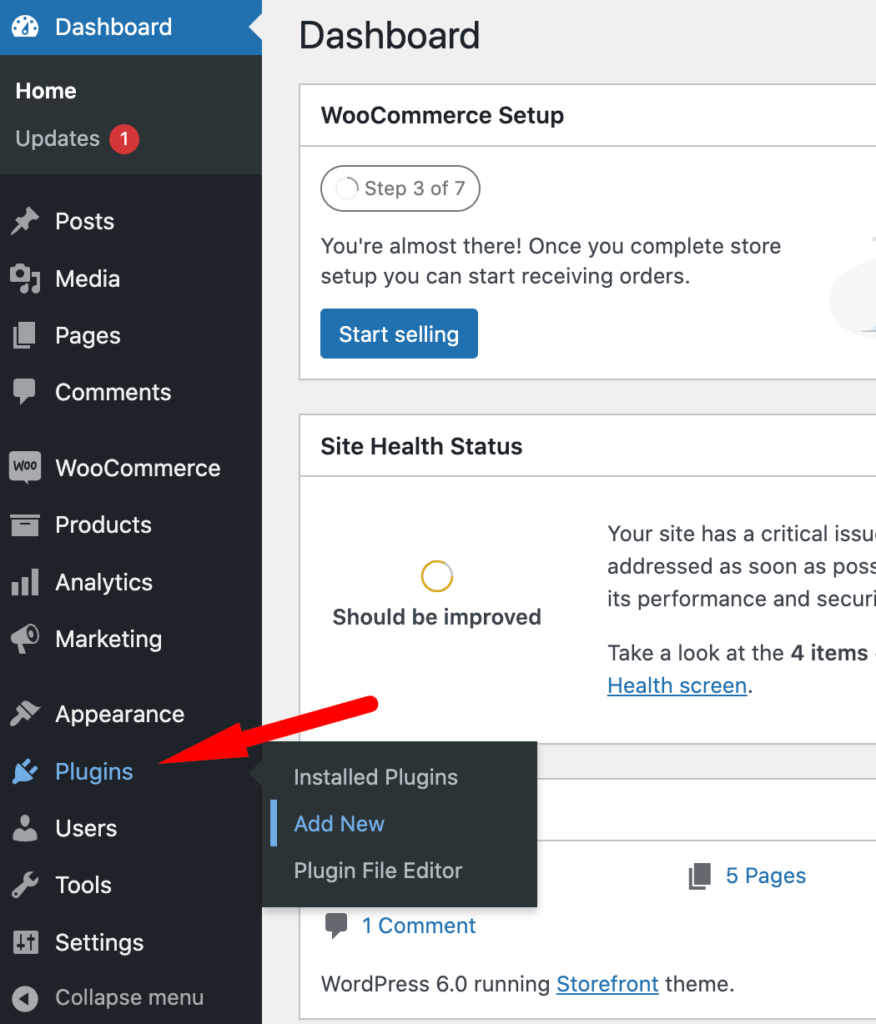
Now type CTX Feed on the search box situated at the top right of the page. From the search result, install and activate the CTX Feed plugin.
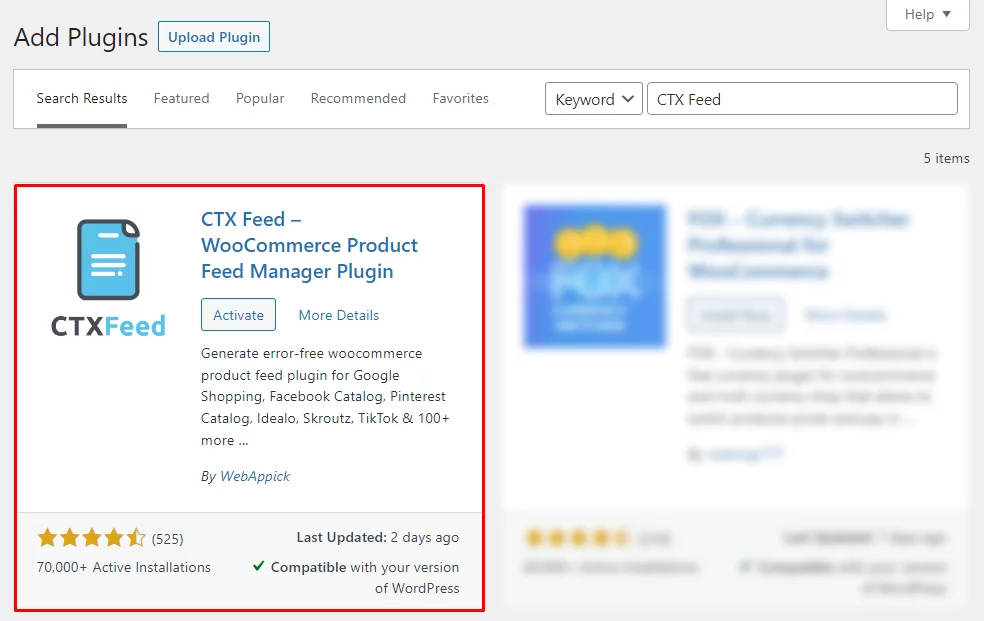
If you want to install the CTX Feed Pro plugin, you can use the “Upload Plugin” button to upload your purchased pro plugin file and then install and activate it accordingly.
You can learn more about CTX Feed Pro installation from here.
We always encourage you to go for CTX Feed Pro to enjoy all the functionalities to the fullest.
CTX Feed Pro comes with exclusive features like attribute mapping, dynamic attributes, advanced filters, multilingual, and multicurrency feeds.
As CTX Feed Pro has both yearly and lifetime licenses for single sites, 5 sites, and 10 sites, you can choose what’s best for your business.
You can learn more about how the CTX Feed Pro version can keep you way ahead from this page.
Step 2: Make the Wish Product Feed with Readymade Template
After installing the CTX Feed plugin, you can start making a Wish product feed from your WooCommere website.
We assure you that the feed-making process for Wish.com with readymade templates from CTX Feed is a piece of cake.
Go to your WordPress admin dashboard and find the CTX Feed menu on the left admin sidebar. Hover on the CTX Feed menu and then click on “Make Feed.”
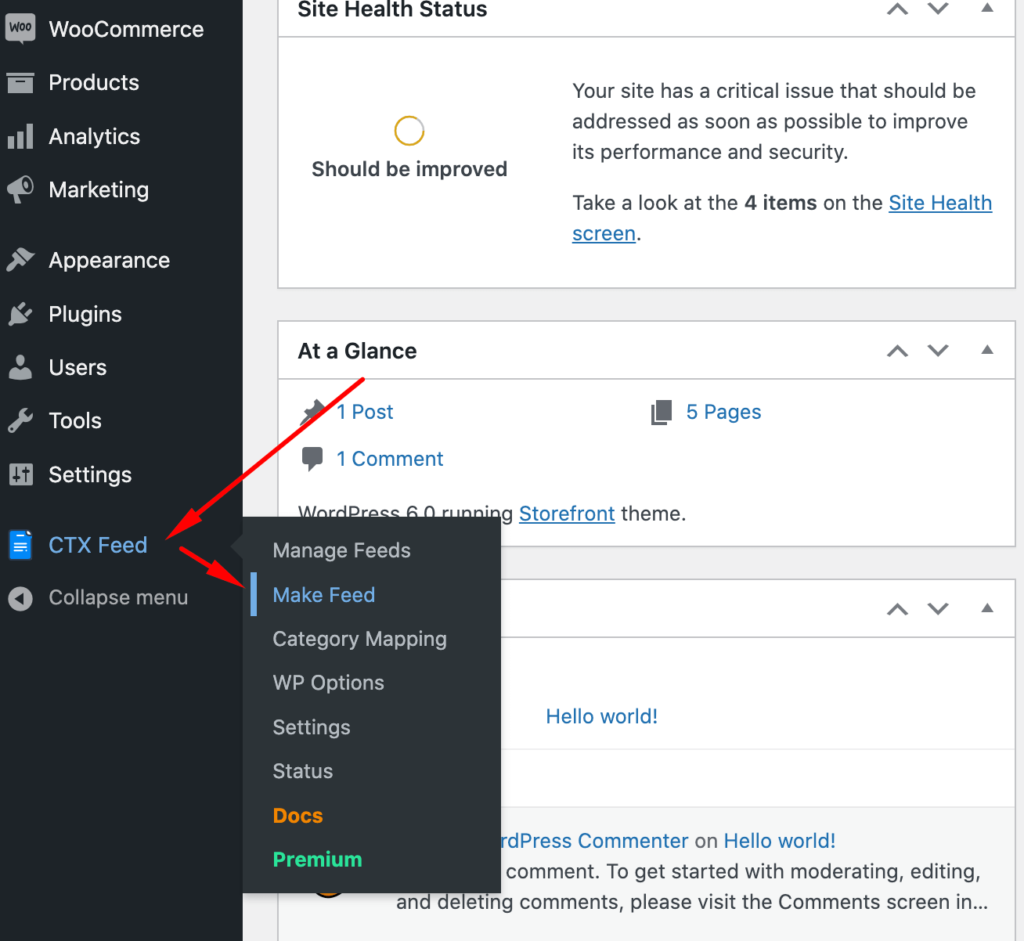
Content Settings
Now it’s time to configure your Wish.com product feed with the premade templates. You’ll find the following options:
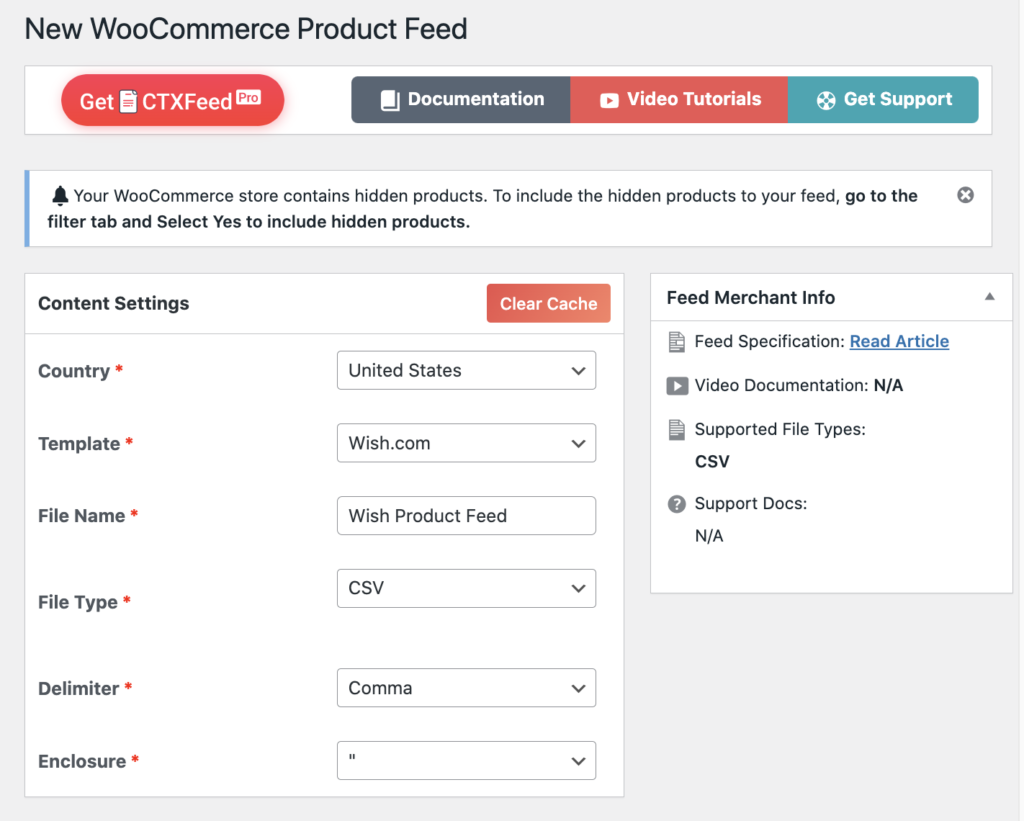
Country: This is manually set as per the location of your WooCommerce store. However, you can change it if you want.
Template: Now choose the Wish.com template from the dropdown.
File Name: Give your Wish product feed a name of your preference. However, avoid using the same name for multiple product feeds. Tweak a word or more if you want to make multiple Wish product feed to distinguish one from the other.
File Type: Choose the CSV file format type from the list. Note that at present, this is the only file type that Wish.com supports to upload products to the platform via product feed.
Include Variations: If you want to include product variations in your product feed then this feature will come in handy. Choose the variation type for your Wish product feed.
Delimiter: It’s there to let you choose the type of delimiter you want to use in your feed to separate items. Though the default delimiter is a comma, you can change it if you want.
Enclosure: Choose from any of the enclosures such as single inverted comma, double inverted comma, and none.
Step 3: Configure the Wish Product Feed
Now it’s time to configure the Wish product feed from your WooCommerce website. Let’s start with the feed configuration with the FEED CONFIG tab.
FEED CONFIG
This is a place of perfect excellence. Here you’ll see that all the required fields you need in a Wish Product Feed as pre-loaded. How did it happen? Well, it’s because you selected the Wish.com product feed template in the content settings.
Apart from the list of default attributes that come with the Wish product feed template of CTX Feed, you can easily add any new attribute just by clicking on the “Add New Attribute” button situated at the buttom of the Feed Config tab.
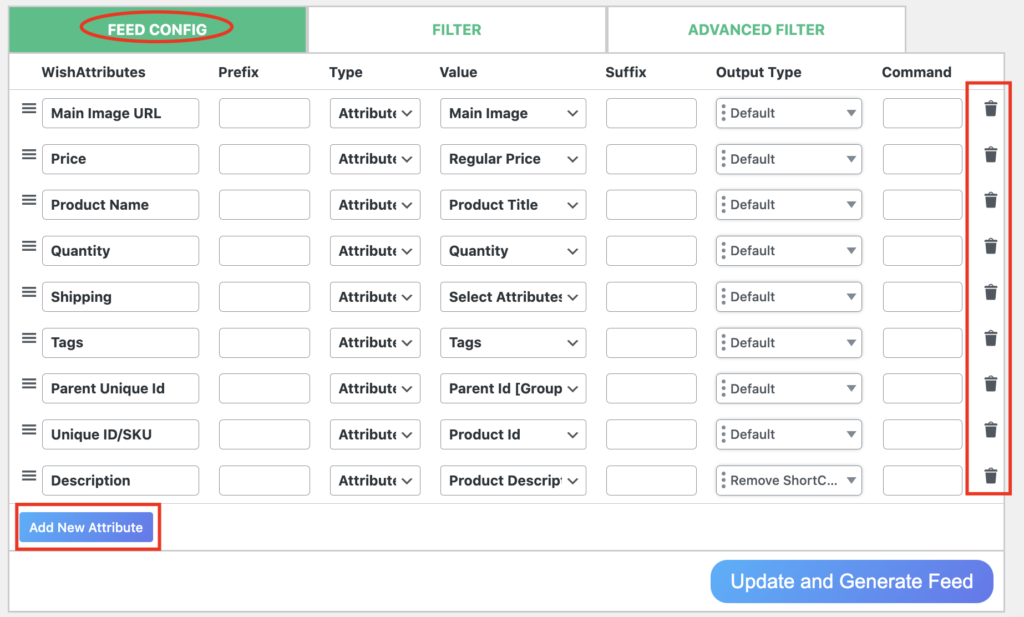
Also, you can delete any Wish product feed attributes from the list by clicking on the delete box you’ll see at the end of every attribute.
Apart from adding and deleting attributes, you can also add prefixes and suffixes, and change the output time, attribute value, attribute type, etc.
FILTER
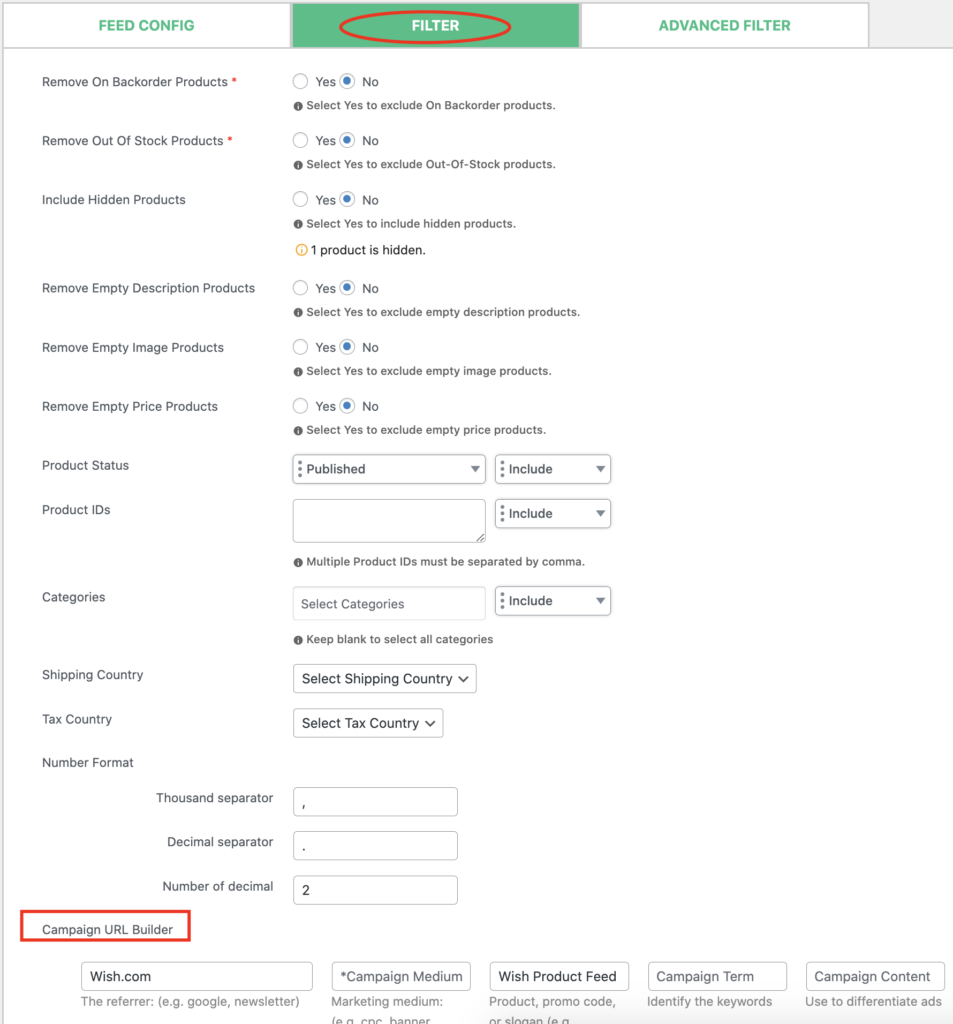
After the FEED CONFIG tab, you’ll see the FILTER tab (for Pro users only). This filter tab will let you do a lot of filtration tasks on your product feed just with a click or two. From here you can use the following filters:
- Remove the backorder products from the feed
- Remove out-of-stock products from the feed
- Include/exclude the hidden products
- Remove empty description products from the feed
- Remove empty image products from the feed
- Include/exclude any product from the feed
- Remove empty price products from the feed
- Include/exclude products based on product status
- Include/exclude products by product IDs
- Include or exclude certain product categories
- Select the shipping country
- Create the campaign URL and more.
- replace the string
ADVANCED FILTER
This is another amazing pro feature of the CTX Feed Pro plugin that will enable you to use multiple conditions while creating your Wish product feed. Advanced filter setting will let you customize the product feed for Wish further.
Other Available Pro Features
Apart from the Filters and Advanced Filters, you can also use attribute mapping, dynamic attribute, category mapping, multichannel, and multicurrency features in the Pro version of CTX Feed.

When you’re all done with designing your content, just click on the “Update and Generate Feed” button.
That’s it.
Now a product feed for Wish.com will be created. You will see a success message once the feed creation is done. Your product feed based on the Wish product feed specifications is ready to be managed.
Step 4: Manage the Feed
Once your Wish product feed is ready, you can easily manage the feed from the product feed management page of CTX Feed.
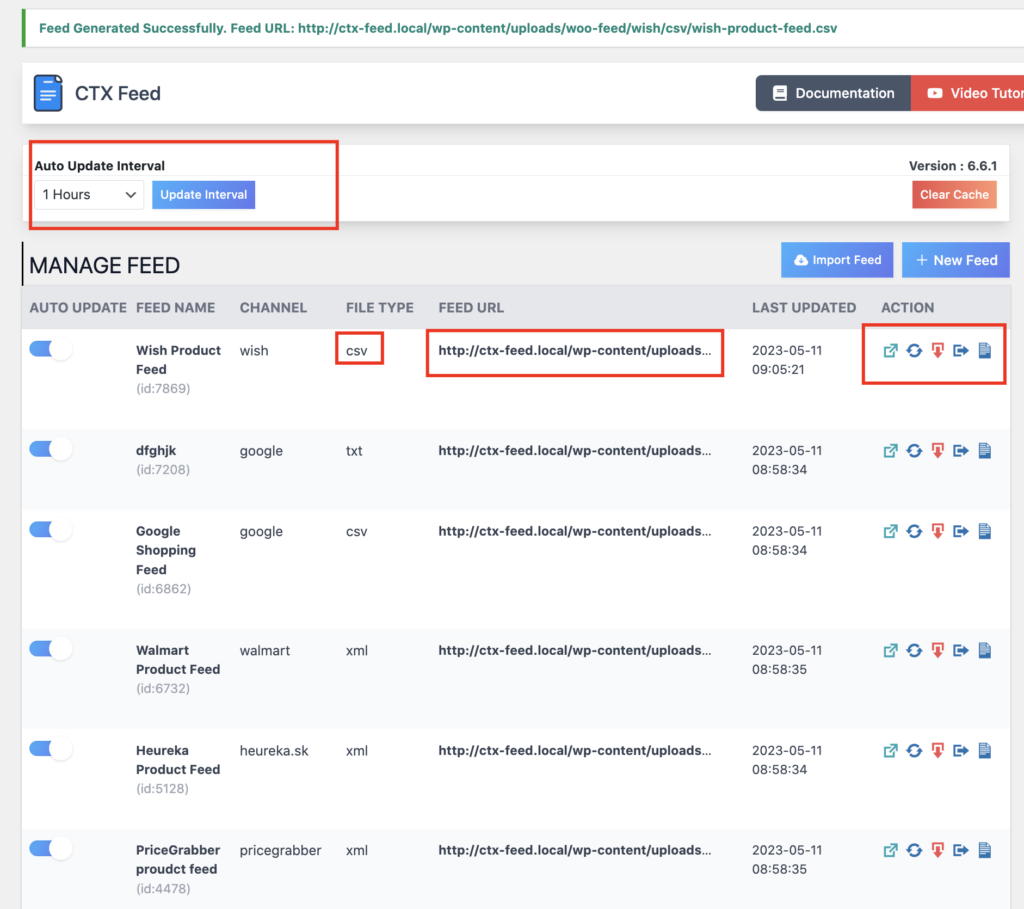
it’s not just the Wish product feed that you can manage from the “Manage Feed”. Instead, you can manage all the product feed that you make using the CTX Feed plugin.
From the “Manage Feed” page, you can download the Wish.com product feed, regenerate it, set feed update intervals, see the feed URLs and feed types, download the feed log and feed, and lots more.
- Check this documentation to know how to manage your product feed
To go ahead to the next step, just download the Wish product feed that you have to upload on the Wish Merchant next.
Step 5: Upload the Product Feed File on Wish
Once you’ve created your Wish product feed with CTX Feed Free/Pro and downloaded that, it’s time to upload the product feed to Wish using your Wish Merchant account.
Frequently Asked Questions (FAQs)
According to Wish.com, there are three ways to add your products to the Wish marketplace:
1. Adding products manually one by one using the Wish Merchant Dashboard. (Use this only if you have just a few products, ideally below 10. Otherwise, it will be a hectic job)
2. Adding products via CSV product feed file (as we’ve shown above)
3. Adding products via API
From Wish.com, you can sell your products to customers of 62 countries that include Canada, Denmark, Finland, Italy, the UK, USA, Sweden, etc. To find out the full list of supported shipping countries and regions, you can read this.
No matter what type of products you sell, probably Wish.com will be a good place for you to sell your products. Below are some categories of products that get sold on Wish.com a lot:
➤ Fashion
➤ Baby gear
➤ Pet accessories
➤ Gadgets
➤ Tools
➤ Health and beauty
➤ Drinks
➤ Home and garden
➤ Sports and outdoor gear
➤ Automotive accessories
➤ Toys and hobbies
➤ Art and craft supplies, etc.
However, to get a complete idea, just visit the official Wish.com website and see the list of categories to find out how diverse kinds of products are sold on Wish.com by the merchants.
Final Thoughts
We hope this blog has helped you learn how to generate a Wish.com product feed from WordPress. If you want to get blogs like this to your email inbox, subscribe to our newsletters. Also, follow us on Facebook and Twitter to stay connected.

